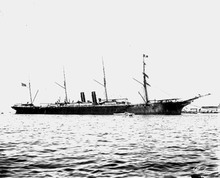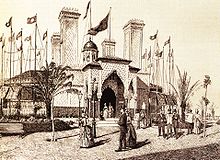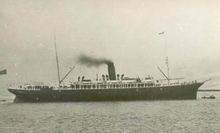- Compañía Transatlántica Española
-
 Ship Colón at Port Said. This CTE ship took part in the doomed attempt to break the US-imposed naval blockade on the Philippines during the 1898 Spanish–American War.
Ship Colón at Port Said. This CTE ship took part in the doomed attempt to break the US-imposed naval blockade on the Philippines during the 1898 Spanish–American War.
 CTE pavilion at the 1888 Universal exhibition in Barcelona. This structure was designed by Antoni Gaudí.
CTE pavilion at the 1888 Universal exhibition in Barcelona. This structure was designed by Antoni Gaudí.
Compañía Transatlántica Española (CTE), also known as Spanish Line in documents in English, is a passenger ocean line that has largely ceased operations although it still exists as a company. It is popularly known as "La Trasatlántica" in the Spanish language (Catalan: "La Transatlàntica").
Contents
History
The Compañía Transatlántica Española's first office in Spain was in Santander in the 19th century and its head office was transferred to Barcelona after Antonio López y López, the owner of the company, married Catalan lady Lluïsa Bru Lassús.
"La Trasatlántica" was established in colonial Cuba in 1850 as "Compañia de Vapores Correos A. López" by Spanish businessman Antonio López y López. It began operations with a 400-ton hybrid sailing ship-sidewheel steamer.
Antonio López was knighted as Marquis of Comillas in 1878. His company changed its name to "Compañía Transatlántica Española", its present name, after being registered as a joint stock company in 1881. Following antonio's death in 1883, his fourth son, Claudio López Bru, took charge of the company. By 1894 the Compañía Transatlántica Española fleet reached 33 vessels with a total of 93.500 registered tonnes.[1]
During the 1898 Spanish–American War, 21 CTE ocean liners were used by the Spanish Navy as auxiliary vessels in order to assist in the war effort. They tried to break the blockade that the United States were imposing on Cuba and the Philippines, the last great colonies of the Spanish crown, but were mostly unsuccessful.[2]
In 1920, after the difficult years of the First World War the Compañía Transatlántica embarked on a considerable expansion and modernization of its fleet. It worked together with the "Sociedad Estatal de Construcción Naval", a Spanish shipbuilding company, in this effort. CTE built well-equipped and luxurious ocean-going steamships that could compete with the best shipping companies of the planet. Claudio López Bru, second Marquis of Comillas, died in 1925.
Following the proclamation of the Second Spanish Republic in 1931, some of the Compañía Transatlántica's ocean liners underwent name changes for political reasons. Vessels named after Spanish royalty and aristocratic figures were re-christened; for example, steamer "Alfonso XIII", named after the newly-ousted king, became ship "Habana", after Havana city in Cuba.
In 1939, as a result of the violence inflicted by both sides of the Spanish Civil War the Compañía Transatlántica saw a great part of its fleet destroyed or in bad state of disrepair. Between 1950 and 1960 the shipping line was able to slowly recover but a storm was gathering which was to have almost lethal consequences for the company.
The arrival of the first passenger jets, like the Boeing 707, and the ensuing popularization of air travel, would deal a mortal blow to the transoceanic shipping lines throughout the world. Compañía Transatlántica shares crashed at the stock exchange and the ailing company was deprived of investors. In 1960, at one of the company's shareholder's meetings the idea was floated to transform CTE into an airline, but funds were not forthcoming. Between the mid-1960s and 1974, CTE liquidated practically all its fleet. One of the last luxury ocean-liners of the company was ship Virginia de Churruca, sold to Trasmediterránea which used it for ferry services to the Balearic Islands. The profits from sales like these, undertaken "at the point of death", were minimal.
In 1978 a non-functional Compañía Transatlántica Española, was integrated into the Instituto Nacional de Industria (INI), an entity of the Spanish state that absorbed failed companies in order to service debt, among other purposes.
In 1994 "La Transatlàntica" became a private company. CTE still survives, but has been only engaged in minor real-estate operations, among other minor businesses. Nowadays the Compañía Transatlántica is not even a shadow of the transoceanic shipping company it was in its days of glory, when its luxury passenger liners cruised the waters of the oceans around the world.
Monuments
The Compañía Transatlántica Española pavilion at the 1888 Universal exhibition in Barcelona was located in its Maritime Section. It was one of the works of famous Catalan architect Antoni Gaudí, better known for the Sagrada Familia. The CTE pavilion was demolished only a few years after its completion to make way for the Passeig Marítim, Barcelona's harbor promedade. Models of this now disappeared structure can be seen at the Sagrada Família museum.[3]
There is a sculptural relief representing a Compañía Transatlántica allegory on one side of the monument "A López y López" in Barcelona. This work was executed by Catalan sculptor Rossend Nobas.
See also
References
- ^ Pictures and history of CTE ships
- ^ List of CTE ships that took part as auxiliary vessels in the Spanish–American War
- ^ Joan Bassegoda i Nonell, Antoni Gaudí (1852-1926), Barcelona, Fundació Caixa de Pensions, 1984. ISBN 84-505-0683-2. p. 236
- This article incorporates information from the equivalent article on the Catalan Wikipedia.
External links
Categories:- Companies based in Catalonia
- Transport in Catalonia
- History of Barcelona
- Companies established in 1850
- Shipping companies of Spain
Wikimedia Foundation. 2010.



